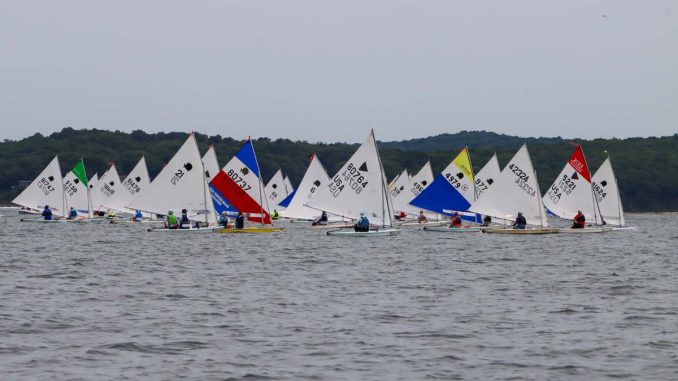
Fifty-four years ago, a group of sailors sat on the beach at the Southold Yacht Club looking across at Shelter Island and mused: “Wouldn’t it be fun to race our 14-foot-long Sunfish around the island?” Thus the “World’s Longest Sunfish Race” was born.
The 53rd iteration took place Saturday, July 20, starting and finishing at the Shelter Island Yacht Club, circumnavigating Shelter Island with competitors sailing in both singles and doubles divisions.
Sunfish are among the world’s most popular boats, with more than half a million built since 1952. Sixty-seven of those boats participated Saturday, carrying 74 sailors, including seven doubles teams, making this one of the largest WLSRs to date.
Sailors hailed from as far afield as Nevada, Georgia and Australia and ranged in age from 16 to 76. It is a very competitive race and, with an actual sailing distance — accounting for tacking and jibing — of around 26 miles, just finishing is an accomplishment.
John Price, 16, who hails from Cutchogue and shared a boat with his sister, Elizabeth, said, “90% of the race was great.” Ruth Hakanson and her daughter, Chloe, straight off an 18-hour flight from Australia, shared a boat and had “the best time ever.” Tom Dunkelman, now in his 60s, first competed in the event at the age of 15. He said he always wanted to give it another go and flew in from Nevada and wound up borrowing race chair Beth Fleisher’s boat.
Chris Williams, coming all the way from Utah, won the race and will have his name inscribed on the WBAZ-FM Plaque, a perpetual trophy. Local sailors Bill Edwards and his wife, Tina, who have traditionally competed in singles, switched it up and sailed doubles on Saturday, placing first in that division. Only time will tell if they go back to singles.
Jack Schultz from the Westhampton Yacht Squadron won the youth award. George Zinger will have his name inscribed on the Heinl-Lyman Octogenarian Plaque: Oldest Competitor and First Master (age 50+) to finish. Isis Shiffer from the Sebago Canoe Club will have her name inscribed on the Peggy Wagner Memorial Plaque for First Female Finisher.
No club event can succeed without staff of volunteers — the backbone of any club. They do all the hard work while the sailors sail. With that said, every volunteer enjoys being a part of the team and spending the day on the water or doing whatever else is necessary to make the club run smoothly. Saturday was no exception, and more than 30 volunteers, including Commodore Gregg Young, who piloted the first safety boat on the water and the last to come ashore, made it possible for all 74 sailors to participate. As both a sailor and a volunteer, this reporter knows what goes into running a club smoothly, and is sure that he speaks for all the participants when he says thank you for all the work the volunteers tirelessly performed.
Prior to racing, Ms. Fleisher held a meeting with all the volunteers explaining their duties and stressing safety. Then she held the skippers’ meeting, again stressing safety. Every sailor had to wear a life jacket, not just have one on board. She made clear that the North and South Ferries had right of way and to stay clear. She also made a point of saying that if a sailor quit racing, he or she had to notify the race committee so that they would not worry and go looking for them. Even though most sailors figured the course would take them counter-clockwise around Shelter Island due to the wind and tide, Ms. Fleisher waited until the end to confirm that was the course. During the meeting, an observant sailor noticed and reported that a boat with sail No. 1 had left the beach to get an early start. There was one minor problem, however: The sailor, Cole Colby, was attending the meeting. He did retrieve his boat and everyone had a good laugh.
Sailing is largely dependent upon the wind, and on Saturday, the prediction was for light wind in the morning, building by late afternoon; it turned out the weatherman was right on. At the start, the wind was fairly light and stayed that way until the boats approached Mashomack, where the breeze started to build. Knowing the local waters and the currents, especially around South Ferry and after passing Mashomack, was of utmost importance, and the race leaders more than likely studied the currents. By the time racers rounded Hay Beach and began the last leg of this marathon, it had really started to blow, at 15 knots, with gusts up to around 18. Not only were sailors fighting the wind, but the wakes from the big boats as well as the choppy waters also made the last leg of the nautical marathon a challenge. Nonetheless, most of the fleet finished within the time frame. The finishing window was 5:12 p.m., with the first boat coming through in just over 4 hours, 44 minutes and the last in about 6 hours.
Congratulations to all the sailors who competed in this nautical marathon.





